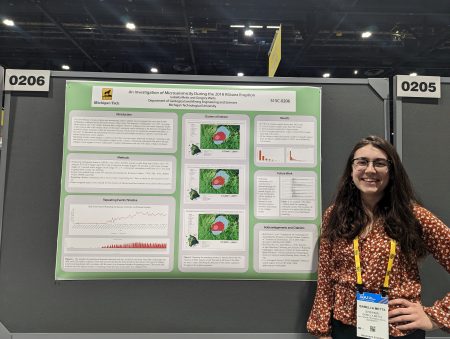Isabella Metts achieved success in defending her geophysics MS research on November 11, 2023.
Advised by Dr. Greg Waite, with Dr. Luke Bowman and Dr. Simon Carn serving as committee members.
Title: An Investigation of Microseismicity During the 2018 Kīlauea Caldera Collapse
Abstract: The 2018 Kīlauea volcano eruption and incremental caldera collapse was accompanied by more than 60,000 seismic events cataloged by the Hawaiian Volcano Observatory as well as 62 caldera collapse events. The majority of seismicity occurred on the eastern side of the caldera between daily collapses. However, the majority of caldera subsidence occurred to the west. To understand the collapse mechanics behind this variance in subsidence and seismicity across the caldera region, repetitive waveforms and source properties can be studied.
Repeating seismic events suggests a common source that is not moving or destroyed. At Kīlauea, clusters of repeating events can indicate source processes throughout collapse cycles. REDPy, a repeating earthquake detector tool for Python, cross-correlates seismic events to determine repetition. Events are separated into families or listed as orphans if no matches are found. We used data from HVO network stations surrounding Kīlauea’s summit. Possible events were identified using an STA/LTA trigger algorithm with a long-time average trigger of 8 seconds, a short-time average trigger of 1 second, and a trigger on/off range of 1-2.5. A minimum correlation coefficient of 0.7 was used to group over 167,000 recognized events from April 29th to August 2nd into nearly 6,000 families. Of these families, 697 were chosen as ‘clusters of interest’ for including >100 events or persisting for 7 days or more. P wave first motions were manually picked for waveforms associated with clusters of interest. These clusters were then located using P wave arrival times, and focal mechanisms were modeled for viable events to learn more about their source processes and relationship to collapse mechanics.
Dilatational first motions dominate our catalog and indicate crack-closing sources with possible relationships to conduit collapse after magma withdrawal and crack closure due to fault motion. Focal mechanism models produced mismatched station polarities indicative of non-double-couple sources, further aiding the hypothesis that dominant events involve a negative volumetric component. Focal spheres show evidence of ring faulting that is likely responsible for these non-double-couple events through the motion of concave fault structures presenting as repetitive crack closure along caldera margins.

